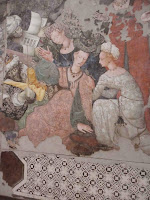the hop-on hop-off bus takes us
to the galleria femminile
honey-combed earth
each cavity resting place for a body
wrapped in cloth
after a year we bring gifts
come with oil lamps
break bread
see the tiny alcove there
we sing their spirits
see how she stands
arms reaching skyward
rejoicing in speech
this god is a bird
alighting on the head
floating away
The hop-on hop-off bus is a great way to get around Rome before you know your way around properly, or if walking is difficult for one reason or another (including tiredness, sore hips, sore feet). It can save you hours in looking for the places you want to see. So my two characters, Diana and Agnese, make the most of it.
The Priscilla catacomb is well worth a visit and it recently made the papers because there is a storm about the fact that the top picture here might represent a woman preaching. She is standing in the traditional position for that.
Some also believe that the second image shows seven women breaking bread. I have a large reproduction of this, so I could see it properly, and it could easily be seven women and there are apparently seven virgins who fit the bill. I name them in another poem and they are: Saturnia
Hilarina Dominanda Rogatina Serotina Paulina Donata.
It also struck me as interesting that god, in these catacombs, is depicted as a bird. Given the incredibly long history of the bird representing numerous goddesses, here is the christian traditionce again repositioning itself and rebadging old images. The gods with wings are relatively late.
Agnese, by the way, was a martyr and she is almost always shown in company with lambs. Diana is one of the many goddesses who gets around with a pack of wolves by her side. The two are more than good friends.
Hilarina Dominanda Rogatina Serotina Paulina Donata.
It also struck me as interesting that god, in these catacombs, is depicted as a bird. Given the incredibly long history of the bird representing numerous goddesses, here is the christian traditionce again repositioning itself and rebadging old images. The gods with wings are relatively late.
Agnese, by the way, was a martyr and she is almost always shown in company with lambs. Diana is one of the many goddesses who gets around with a pack of wolves by her side. The two are more than good friends.












